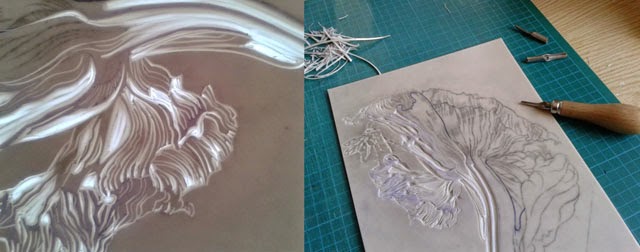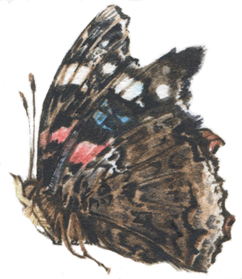April 1st, 2014
In my blog from a week ago I spoke about making a print in a new material: SoftCut.
Making a print, doesn’t matter if it’s an etching, drypoint or linocut, is always a difficult
thing for me because I hurt my hand in 2008. Things got overworked, inflamed, my thumb
hurt like crazy and for about a year I couldn’t do anything. Writing, drawing, even holding a book
during reading was a challenge.
Over time things got better but my hand is still not the way it used to be. I can’t work long
hours, I had to stop all printing activities and I switched from pencil and pastels to drawing inks.
Progress is still made, the amount of time I can work increases. Recently I started a drawing in
pencil, something I couldn’t do for a long time. Still I have to be very careful not to overdo it.
So making a linocut was a big challenge.
This is why I set out to look for a material that would give the impression of a linocut but
would be more easy to cut. I made some stamps out of big erasers but with erasers size
is limited. At Hoopman Artsuplies I found SoftCut.
It has pros but also quite a few cons, especially when you are used to linoleum. SoftCut is a
flexible sheet of rubber. It has one smooth and one less smooth side. The smooth side is the
side to cut. It doesn’t have a woven structure like linoleum, it’s just rubber.
SoftCut is available in different sizes varying from 75x75 mm to 200x300 mm.
Pros:
- For me and my problematic hand SoftCut was great. My tools would just cut through the
surface (almost) like butter.
- If you want to cut a round shape you don’t have to stop or be extra careful not to mess up
your work. You can easily take the corner by twisting your hand/ tool or by twisting SoftCut
into the right direction.
- It doesn’t break like linoleum does so it’s very suitable for detailed work.
- Flexibility makes it possible to make prints on curved surfaces.
Cons:
- The biggest size SoftCut available is 200x300 mm. Much smaller than linoleum. The print
Jantine and I did was actually made by printing 2 sheets of SoftCut next to each other so the
size would be 200x600 mm. This was because of SoftCuts flexibility not an easy task.
- When you cut linoleum the last bit of the snippet kinda breaks off, you don’t have to
finish the cut. SoftCut doesn’t do that, you have to remove the snippets by pulling them off
which takes time.
- To trace our design on the SoftCut Jantine and I first tried to use carbonpaper but that would
not take! Pencil did take and ballpoint did too but both would easily smudge or disappear
altogether.
- Flexibility was also a con because during the whole printing process the shape of the SoftCut
sheet would not remain the same. We had to take off all pressure of the press so it would not
smudge, or compromise SoftCuts shape. So better to use a baren instead of a press.
For me SoftCut is a great new material which allows me to finally continue my printing career
but I think most artists who don’t have similar problems like mine will stick with linoleum.



